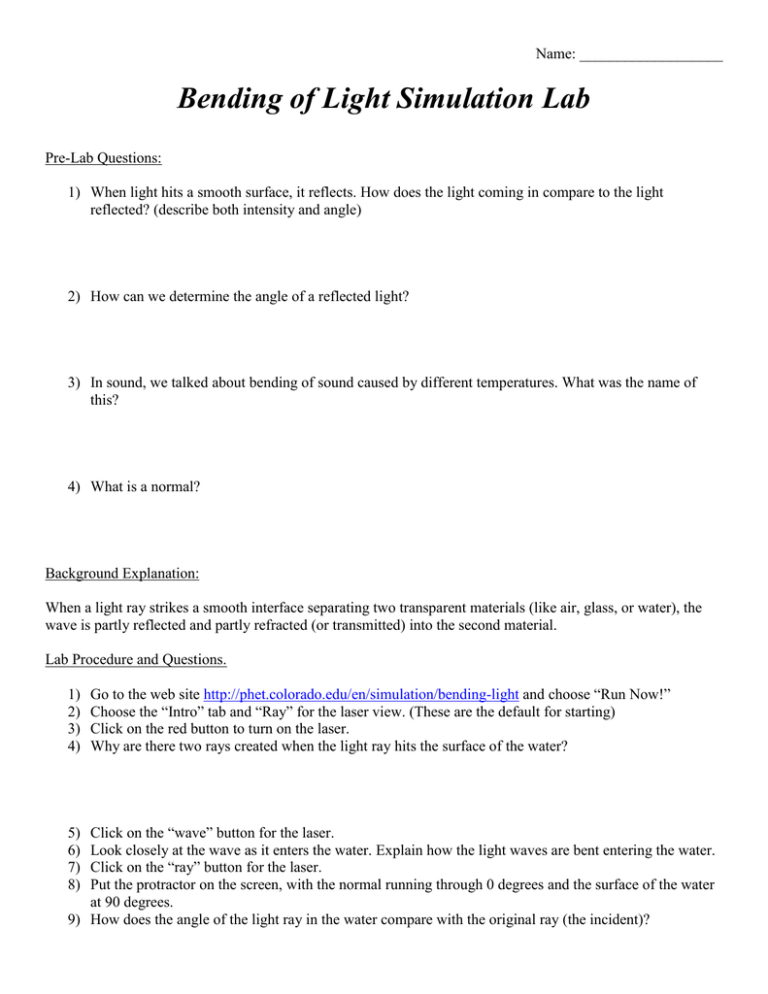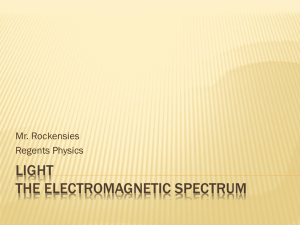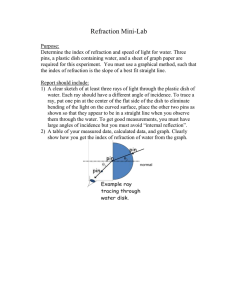Bending of Light Simulation Lab Worksheet
advertisement

Name: ___________________ Bending of Light Simulation Lab Pre-Lab Questions: 1) When light hits a smooth surface, it reflects. How does the light coming in compare to the light reflected? (describe both intensity and angle) 2) How can we determine the angle of a reflected light? 3) In sound, we talked about bending of sound caused by different temperatures. What was the name of this? 4) What is a normal? Background Explanation: When a light ray strikes a smooth interface separating two transparent materials (like air, glass, or water), the wave is partly reflected and partly refracted (or transmitted) into the second material. Lab Procedure and Questions. 1) 2) 3) 4) Go to the web site http://phet.colorado.edu/en/simulation/bending-light and choose “Run Now!” Choose the “Intro” tab and “Ray” for the laser view. (These are the default for starting) Click on the red button to turn on the laser. Why are there two rays created when the light ray hits the surface of the water? Click on the “wave” button for the laser. Look closely at the wave as it enters the water. Explain how the light waves are bent entering the water. Click on the “ray” button for the laser. Put the protractor on the screen, with the normal running through 0 degrees and the surface of the water at 90 degrees. 9) How does the angle of the light ray in the water compare with the original ray (the incident)? 5) 6) 7) 8) Name: ___________________ 10) Change the second material from water to glass. How does the angle of the light ray in the water compare with the incident ray? 11) Go to the “More Tools” tab, and turn the light on. 12) Choose the speed tool, and measure the speed of the incident ray and the refracted ray. How do they compare? 13) What is the relationship of the new speed of light and the index of refraction? 14) Change the material from glass to water. Measure the speed of the incident ray and the refracted ray. How do they compare? 15) Is the relationship of the new speed of light and the index of refraction the same? 16) Go back to the “Intro” tab and choose “Waves” for the laser view. 17) Use what you now know about the speed of light entering a new material to explain why the waves bend when entering the new material. Name: ___________________ Snell’s Law: Snell’s Law describes the behavior of light as it passes from one material into another. As the material changes, the speed of light changes. As the speed of light changes, the waves are bent. This causes the refraction of light as it passes into a new material. Terms: θ1 is the angle of the incident ray in relation to the normal. θ2 is the angle of the refracted ray. Complete the following table Top Material Bottom Material n1 θ1 n2 θ2 sin θ1 sin θ2 n2 n1 As you can see, the last two columns are the same. From that, the formula for Snell’s law is derived: n1sinθ1 = n2sinθ2 Applying Snell’s Law: 1) If an incident ray enters a piece of plastic at 59 degrees, and has an angle of refraction of 43 degrees, what is the index of refraction of the plastic? (Index of Refraction of air is 1) 2) If the incident angle is 53 and n1 = 1.12, and the angle of refraction is 41, what is n2? 3) The index of refraction of air is 1, the index of refraction of quartz is 1.458. If the incident angle is 33 degrees, what will the angle of refraction be?






